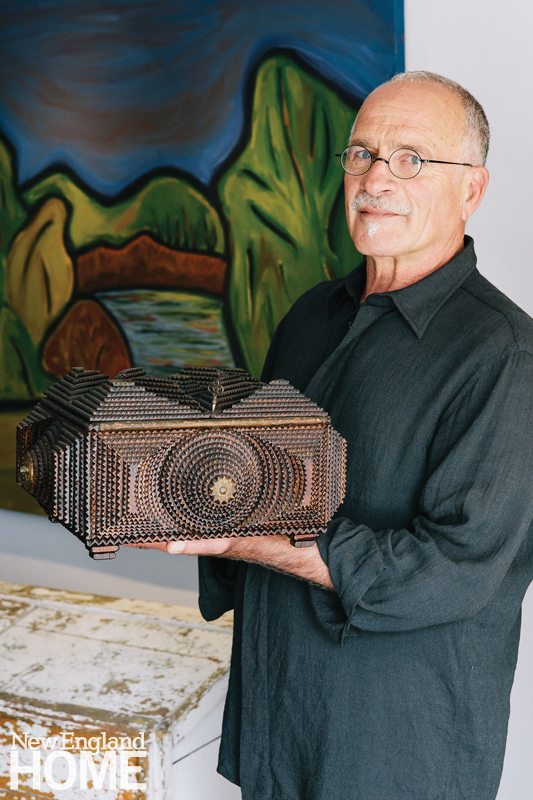Five Questions: Thomas Antonelli
July 7, 2016
In addition to selling your own paintings, you’ve become a collector and seller of what’s known as Tramp art. How did you get interested?
Text by Robert Kiener Photography by Elizabeth Cecil
 1. In addition to selling your own paintings, you’ve become a collector and seller of what’s known as Tramp art. How did you get interested?
1. In addition to selling your own paintings, you’ve become a collector and seller of what’s known as Tramp art. How did you get interested?
In the 1960s and 1970s, I started picking things up that people were throwing out but that I thought were interesting. The first time I saw Tramp art I felt it had so much presence, so much soul, that it resonated with me. I realized I was looking at something I had never seen before. I had to have it. Tramp art is a branch of folk art, a woodworking style that uses small pieces of wood, often whittled into geometric shapes. It can be anything from a box made out of matchsticks to a picture frame built up from a cigar box to larger furniture. Most pieces were made between the 1870s and the 1940s.
2. What is it about Tramp art that appeals to you?
The pieces have so much spirit. Each one displays the hand and the heart of the maker. For example, I own a really classic piece of Tramp art that I love so much I could never sell it. It is a big jewelry box, built up and personalized and with embroidery and velvet inside. It includes both “To” and “From” initials; it was definitely a love token. But it also has a mystery because it doesn’t look like it has ever been used. You could create a whole romance, an entire novel centered on it, perhaps an unfinished love story. It is a jewelry box without a trace of jewelry in it. Like a lot of Tramp art, it exudes love and passion.
3. How do you find Tramp art to sell in your gallery?
In the 1970s and ’80s I could find it in dusty corners of antique shops and even in people’s attics. Today more people are aware of its value; even collectors and museums are competing for the best items. It has become so popular that you can simply go online and find great examples of it for sale. It’s also for sale at antique shows, which I prefer. I have to hold a piece, feel it, and look at it. That’s the thing about Tramp art, when you hold it you feel its soul and its spirit.
4. What is the current market for Tramp art?
Unlike a lot of folk art that has been collected for generations, Tramp art has really only been collected for the last half century or so. That was by a sophisticated group of people who were willing to accept this strange thing. But now is a very exciting time for Tramp art. There have been books written about it and it has finally been recognized as folk art. It has its own place in history now. On the antique market it is holding its own, regarding price. It is a great area to start collecting; because it is so unique and one of a kind.
5. Who is buying it?
The complaint you often hear in the antique business is, “Young people aren’t interested in antiques.” But I am selling Tramp art to young people who seem so busy, so consumed by technology, but when they see a piece of this folk art they slow down and say, “Wow! I have to have it!” Technology cannot produce these pieces; there is no iPhone app for whittling! When I sell a piece I feel great joy; there are now people who love it and have a passion for it, and I know have a special place in their lives for it.
Antonelli Giardelli Gallery, 416 Commercial Street, Provincetown, (508) 487-9693
Share
![NEH-Logo_Black[1] NEH-Logo_Black[1]](https://b2915716.smushcdn.com/2915716/wp-content/uploads/2022/08/NEH-Logo_Black1-300x162.jpg?lossy=1&strip=1&webp=1)









You must be logged in to post a comment.